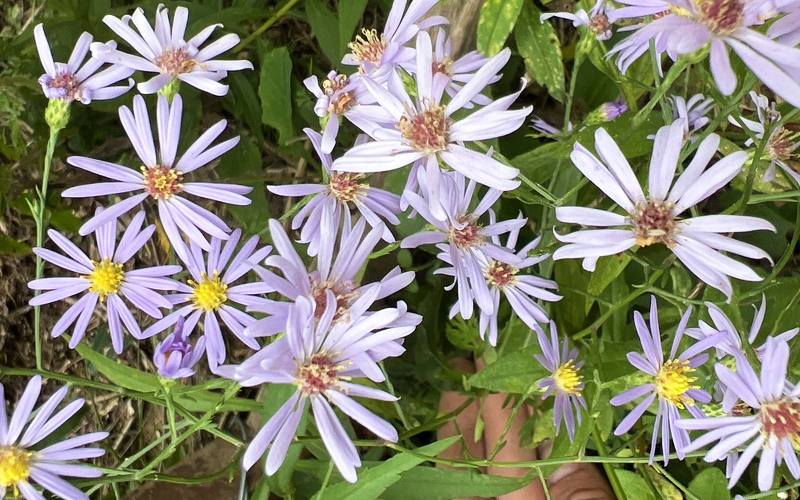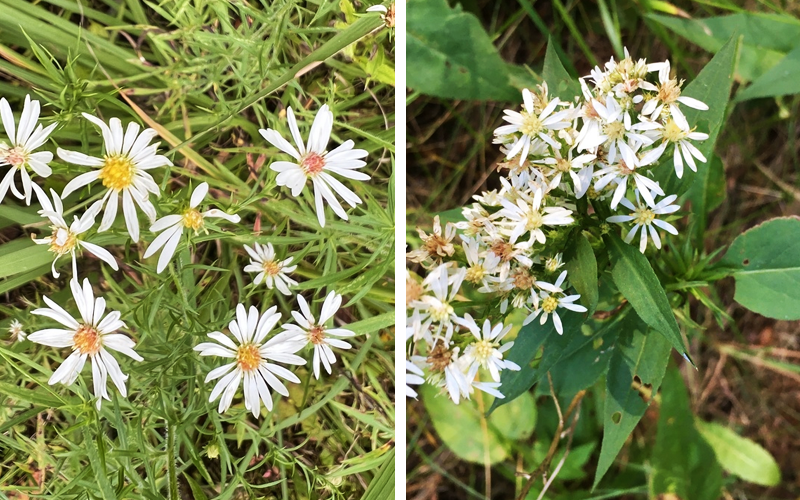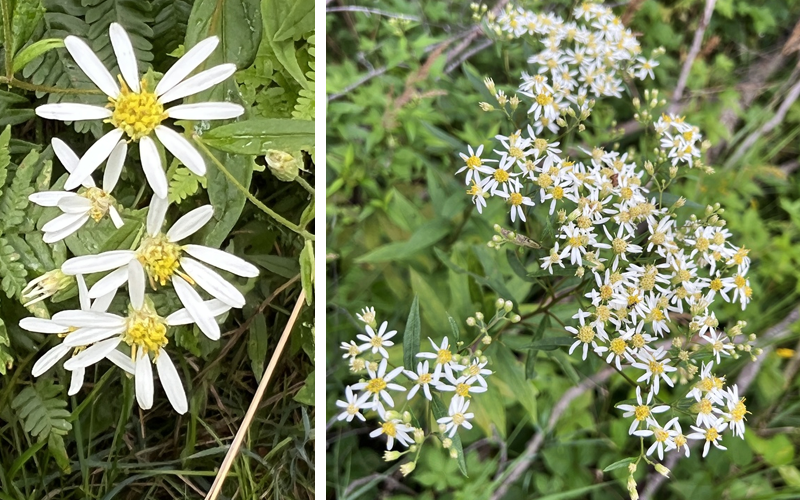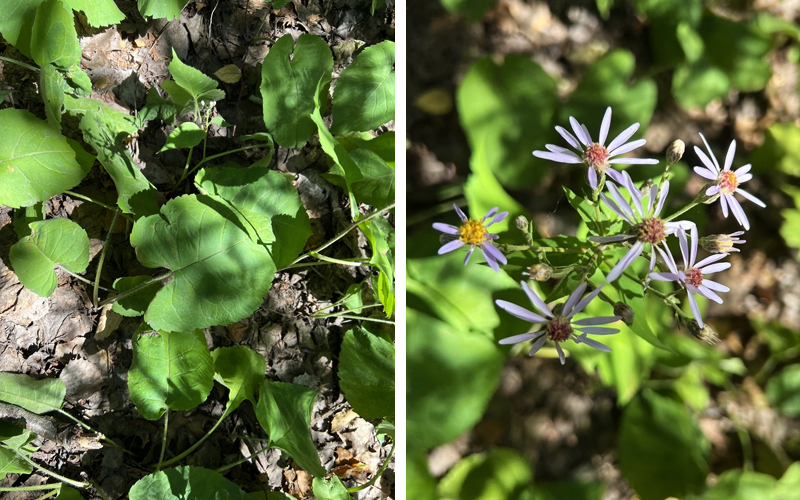Autumn Nectar for Bees and Butterflies Ontario’s Native Asters
With autumn comes the emergence of two major groups of native wildflowers: goldenrods (Solidago sp.) and asters (Symphyotrichum spp.). Their late blooming time, after other native wildflowers have faded, makes these wildflowers ecologically important to many species. They are a vital food source to pollinators; especially native bumblebees and south-migrating Monarch butterflies (Danaus plexippus), which feed on the large amounts of nectar and pollen produced by aster flowers. When the flowers emerge in September, the vibrant florets of aster species attract bees and butterflies.
Both groups of wildflowers are highly diverse; each constituting more than 15 species. Native wildflowers commonly known as “Aster” are divided between four genera; the “typical” Asters (Symphyotrichum sp.), the Wood Asters (Eurybia sp.), the Whorled Asters (Oclemena sp.) and the Flat-top Asters (Doellingeria). This blog post will display visuals and identification types for the more common species of Asters.
The showiest of the native asters is the New-England aster (Symphyotrichum novae-angliae). From late August, this verdant aster displays purple flowers up to 4 cm across; very large for an aster. Each autumn, New-England aster produces a long-lasting display with many individual plants flowering vigorously through October. Plants grow up to 1.5m tall.

New England Aster, London ON, Sept 2022
Smooth Blue Aster (Symphyotrichum laeve) is another of the more gorgeous species. Flowers are large, up to 3 cm across. This species occurs in meadows and open woodlands, often along forest edges. Smooth Blue Asters are smaller than New England Asters, only to around 1m tall.

Smooth Blue Aster, Hawk Cliff Woods, Elgin County ON, Sept. 2022
Calico Aster (Symphyotrichum lateriflorum) occurs in meadows throughout Ontario. In September, white flowers appear around 1 cm across, with a distinct purple center. This aster has narrow, lance-shaped leaves, and stems covered in fine plant-hairs.
Panicled Aster (Symphyotrichum lanceolatum) is among the more abundant white-flowering asters. Panicled Aster is very showy; producing dozens of 2-cm wide flowers. Tolerant of a wide variety of habitats, Panicled Aster appears in meadows, forest edges, and often along walking trails.

L: Calico Aster, London ON, Oct. 2020. R: Panicled Aster, London ON, Sept. 2020
Aster diversity increases as one travels south and east of Lake Superior. White Oldfield Aster (Symphyotrichum pilosum) is a very common southern species, occurring north to Manitoulin Island in Ontario, and St. Ignace in Michigan. A distinguishing feature of this species is that flowers are only found on one side of the plant (secund). Arrow-leaved Aster (Symphyotrichum urophyllum) is another common aster in the southern Great Lakes region. While similar to other white-flowering asters, the arrow-shaped leaves help identify this particular species. Short’s Aster (Symphytorichum shortii) is much more southerly, being found only in the southernmost counties of Michigan, and near Pelee Island, Ontario.

L: White Old-Field Aster, Lambton County, ON, Sept 2022. R: Arrow-leaved Aster, Norfolk County, ON, Sept. 2020

L: Short’s Aster; Oct 2023. R: Swamp Aster, Mississagi PP, Aug 2022
Swamp Aster (Symphyotrichum puniceum) is an abundant species within marshes and wet meadows. Swamp Asters are found locally in the Algoma Region, and as far north as Wawa. It can be readily identified by the large, pale-purple flowers, which are up to 4 cm across, reddish-stems, and the tall plant height, up to 2m.
Lindley’s Aster (Symphyotrichum ciliolatum), is found between the deciduous and boreal forest zones, especially within areas of the Canadian Shield. Flowers are blueish-purple, and up to 4cm in diameter. Habitat is shrubby meadows and woodland edges. Leaves are typically heart-shaped, and stems are reddish in color. The plant height is much smaller than Swamp Aster, only to 1m.

L: Lindley’s Aster – Whitefish Island, Sault Ste Marie ON, Aug. 2023. R: Lindley’s Aster – Peterborough ON, Sept. 2021
The Flat-top White Aster (Doellingeria umbellata) is an abundant species in open woodlands and shrubby meadows. The flowers, which are 2 cm across, can occur as early as July. A distinguishing feature is the flower location, which is typically only at the top of the plant. Flat-top White Asters grow up to 2m in total height (much taller than other species of white-flowering aster).

Flat White-topped Aster. L: Killarney PP, Aug. 2022. R: Sault Ste Marie, Aug. 2023
Large-leaved aster (Eurybia macrophylla) is by far the most common aster species in forests. It is especially abundant in dry forests, which usually include northern red oak, red pine and white pine as canopy tree species. In these forest types there are large densities of large-leaved aster, covering much of the forest floor. High densities of large-leaved Aster also occur in sugar maple – red oak forest types, if the site is dry. However, large-leaved asters are not usually found in high densities within moist or wet forest types (such as the Sugar Maple – Yellow Birch dominated areas along the southeastern coasts of Lake Superior). Here, large-leaved asters are often replaced by more moisture and shade-tolerant vegetation. This species is not found in swamps as it does not tolerate long periods of flooding.
Large-leaved asters can be readily identified by their heart-shaped leaves, which are almost equally long and wide. This species has among the largest leaves of all native asters, to 20 cm in diameter. Their purple flowers, measuring 3 cm across, bloom from late July to October. The flower location at the tip of a flowering stem is another distinguishing feature. The plant is easily identifiable by the leaves, habitat, and the plant height (usually under 60cm tall).

Large-leaved Aster, Michigiwadinong, Manitoulin Island, July 2023
Bog aster (Oclemena nemoralis) is a small, hemiboreal species of peat bogs and other wetlands. Bog asters are rarely found outside of their preferred habitat. They have distinctive, whorled leaves. Flowers are pale-purple, to 4cm in diameter. Typically there are only a few flowers at the top of a 50 cm high plant.

Bog Aster, Lake Superior PP, August 2020
Other Aster species in Ontario:
- Sky-Blue Aster (Symphyotrichum oolentangiense)
- White Heath Aster (Symphyotrichum ericoides)
- Boreal Aster (Symphyotrichum boreale)
- Ontario Aster (Symphyotrichum ontarionis)
- Common Blue Wood Aster (Symphyotrichum cordifolium)
- Crooked-Stem Aster (Symphyotrichum prenanthoides) [Elgin County area only]
- White Wood Aster (Eurybia divaricata) [Norfolk County area only]
- Whorled Aster (Oclemena acuminata) [Frontenac Arch area only]
- Rayless Aster (Symphyotrichum ciliatum)
- Saltmarsh Aster (Symphyotrichum subulatum)

